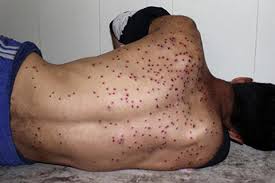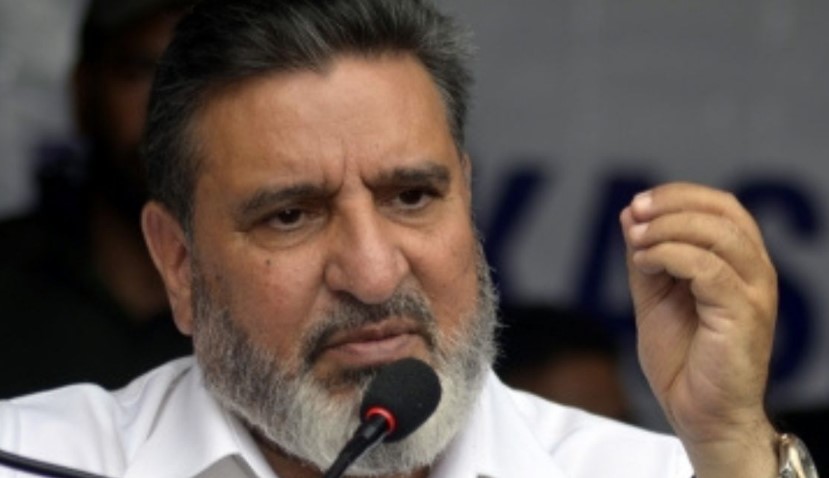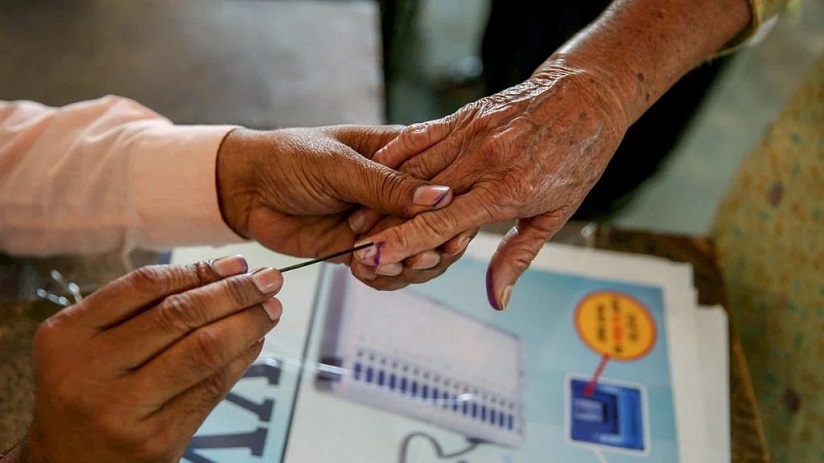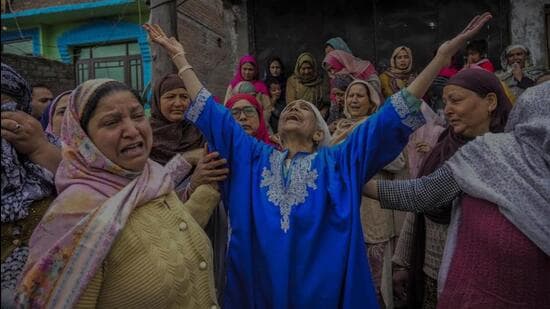- 12 Year old schoolboy’s killing again puts a spotlight on lethality of pellet guns
- In just 90 days, Junaid becomes 14th victim of so-called non-lethal weapon
- 65 more persons arrested in 24 hours: Police
 With pellets causing death of 12-year-old schoolboy in Srinagar on Saturday morning—triggering widespread protests and outcry—the lethality of this crowd control weapon has once again come into focus in Kashmir.
With pellets causing death of 12-year-old schoolboy in Srinagar on Saturday morning—triggering widespread protests and outcry—the lethality of this crowd control weapon has once again come into focus in Kashmir.
Junaid Ahmad from Srinagar’s Eidgah locality was hit by pellets in his head and chest on Friday, leading to his death at the SK Institute of Medical Sciences here on Saturday. Junaid’s death triggered massive protests in several areas, apart from widespread condemnations from across the political divide in Kashmir. Junaid is the 14th victim of the deadly pellets that the government had pitched as “non-lethal ammunition” for crowd control, in a span of three months.
Apart from these 14 deaths, pellets have also been responsible for injuries to eyes of more than 1000 people since July 9—the day protests broke out across Kashmir over the death of Hizbul Mujahideen commander Burhan Muzaffar Wani a day earlier. Most of the victims hit in eyes are school going children and teenagers, according to doctors here.
Although there has been a massive outcry across Kashmir, as well as in the international media, over the ‘indiscriminate’ use of pellets on street protesters, the state government has justified its use. And despite assurances from no less than the Home Minister of India Rajnath Singh that the use of pellets would be “reviewed”, nothing has changed on ground.
On July 26, the Ministry of Home Affairs had constituted a seven-member committee for exploring alternatives to the pellet guns after these wreaked havoc across Kashmir. But barely a few days after the announcement, a Joint Secretary in the Ministry, TVSN Prasad, who headed the seven-member committee, clarified that pellet guns would not be discontinued but used in ‘rarest of the rare cases’—something that evoked widespread criticism.
The committee recommended use of PAVA shells, a 1000 canister consignment of which was flown to Kashmir on September 4—the day an all-party parliamentary delegation visited the Valley. However, the shells were not put to use due to ‘certain issues’ including ‘poor emission and efficacy’ reported by forces who ‘test fired’ these in Kashmir.
Pellet injuries in eyes, according to doctors, are causing vision impairment of varying degree and even total blindness in some cases.
Insha Malik, the 14-year-old girl from Shopian—who lost her both eyes to pellets—is one such victim. Doctors say there are at least 50 more persons whose both eyes have been hit by pellets.
The cases of damage to vital organs due to pellet injuries have also been profiled in the past 90 days and many people have a permanent disability starring in their faces due to such injuries, doctors said.
18-year-old Mohsin, a youth from southern Pulwama district who was hit by an ‘entire cartridge of pellets’ in his spine is confined to bed, doctors said, and as per hospital records, many others have suffered brain damage due to this so-called non-lethal weapon.
As per records consolidated from hospitals across Kashmir, more than 7000 people have suffered injuries due to pellets in the past three months. On October 13, the figure of injuries due to pellets stood at 7136.
Since the announcement for exploring the alternatives to pellet guns was made by Rajnath Singh during a press conference in Srinagar, five people lost their lives to pellets and about 500 more were hit in eyes and thousands more injured in parts of their bodies (other than eyes), including some vital organs.
On September 22, 2016, the High Court of J&K refused to ban use of pellet guns as a weapon of crowd control. Earlier, police had submitted before the Court that ‘handling of law and order situation is the constitutional and legal duty of the State’ and ‘What method is required to give effect in order to control law and order has to be left to the State’.
Police had also claimed that ‘pellet gun (12 Bore Pump Action Gun) is sparingly used when all other modes of crowd control i.e. tear gas, oleoresin grenades, stun grenades fail to yield any desired results.”
Doctors opine that the known pellet deaths might not be the exact figure of causalities attributable to this weapon. “In some cases, in the initial few days of protests, some people died and were not brought to hospitals. Some of them might have died of pellets,” they said.
Doctors at SMHS Hospital reported that a youth aged about 20 was brought to the hospital with severe pellet injuries in his head but could not be admitted due to his death ‘within minutes of reaching the hospital’. He is recorded only as a short stay patient with his name not known.
“A spray of pellets had pierced his head making a large hole on one side and exited from the other side,” a doctor said. “His whole brain was shattered.”
Meanwhile, curfew remained in force in interior areas of Srinagar, while there was semblance of normalcy in the uptown city as the weekly flea market opened here, but life elsewhere in the Valley remained affected.
Meanwhile, continuing with its crackdown, police arrested 65 persons for “creating public disorder and disrupting normal activities” in a span of 24 hours.
Curfew was imposed in five police station areas of Srinagar — Nowhatta, Khanyar, Rainawari, Safa Kadal and Maharaj Gunj — as a precautionary measure, a police official said. The curbs have been lifted from two police station areas – Maisuma and Batamaloo, the official said.
The situation in interior areas of the city remained tense after a minor boy succumbed to pellet injuries here, sparking fresh clashes between protesters and government forces at various places on Saturday.
In the uptown areas of the city, especially around the commercial hub of Lal Chowk, there was an increased movement of private cars and auto-rickshaws today as compared to the last two days. The weekly flea market, popularly known as Sunday Market, also opened today as more than 100 vendors set up their stalls along the TRC Chowk-Batamaloo axis in the city.
Meanwhile, normal life remained affected for the 93rd consecutive day in the rest of the Valley following killing of Hizbul Mujahideen commander Burhan Wani on July 8. The unrest, which has claimed 91 lives and left thousands of others injured in clashes between protestors and forces, is in its fourth month as shops, business establishments, petrol pumps and educational institutions remained closed, while public transport continued to be off the roads.
Top separatist leaders and youths have been arrested by police over the past three months for allegedly inciting violence. Over 300 persons have been booked under Public Safety Act (PSA). Clashes were reported from Saidapora area of Eidgah as angry residents protested against the death of a local 12-year-old boy, Junaid Akhoon, who succumbed to pellet injuries on Saturday. As per witnesses, police and paramilitary CRPF personnel used tear gas shells to disperse the protesting youth who were pelting stones at them. Clashes were going on in the area till late evening.
Women in Batamaloo area staged protest in the locality during which anti-India and pro-freedom slogans were raised.
Meanwhile, residents of Narbal area in central Kashmir’s Budgam district alleged that government forces used force against women who were protesting against the arresting of a youth and ransacked several residential houses. Dozens of women staged protest against the arrest of a local youth, Arif Ahmad Rather. Arif was detained early morning as he was out to buy bread, locals said. According to a statement issued by police, the situation remained by and large peaceful across Kashmir although a couple of stone pelting incidents were also reported.






